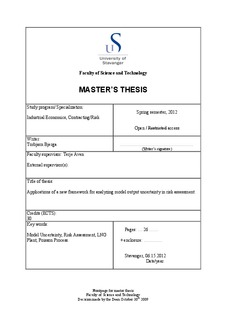Applications of a new framework for analyzing model output uncertainty in risk assessment
Master thesis
Permanent lenke
http://hdl.handle.net/11250/182125Utgivelsesdato
2012Metadata
Vis full innførselSamlinger
- Studentoppgaver (TN-ISØP) [1441]
Sammendrag
The framework:
In both papers we introduce the new framework for analyzing model (output) uncertainty in models
used in risk assessment. The framework applies when no experimental data are available at the time of
the risk assessment, and the main features can be summarized as follows (a more detailed description
can be found in Paper I and II and the references within):
The following concepts and distinctions are given in the framework:
• The concepts and distinction between model error and model output uncertainty:
The difference between a true value of interest to be realized in the future, Z, and the
model outcome (prediction) G(X) is called the model error, ΔG(X)=Z-G(X). Model
output uncertainty is the epistemic uncertainty about the magnitude of the model error,
ΔG(X).
• The concepts and distinction between structural model uncertainty and input quantity
(parameter) uncertainty:
The concept model output uncertainty is divided into structural model uncertainty and
input quantity (parameter) uncertainty. The structural model uncertainty is the model
output uncertainty about the magnitude of the model error conditional on the true input
quantity, ΔG(XTrue), while the input quantity uncertainty is uncertainty about the true
value of the input quantity, X.
• The concept and distinctions regarding sources of uncertainty:
Sources of uncertainty are classified as belonging to either the input quantity
uncertainty or the structural model uncertainty. Sources of input quantity uncertainty
are sources that give uncertainty about the value of X. While sources of structural
uncertainty are typically assumptions and approximations underpinning the model. The framework also links the concept of model output uncertainty to the objectives of modeling and
risk assessment and specifically model accreditation is given focus. Meaning that the models needs to
have a certain level of quality for its intended use (the purpose) in the risk assessment and subsequent
decision making process. In addition the framework is open for various tools to represent the epistemic
uncertainties. [...]
Beskrivelse
Master's thesis in Industrial Economics
